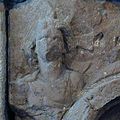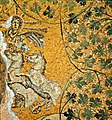Sun cult
Sun cult or sun worship (also sun religion or sun worship ) describes a religion or a cult whose central motif of orientation or worship is the sun . The physical central star of the solar system represents the supreme deity , e.g. B. in the form of a personified sun god , or the highest power of the respective cosmology .
history
Old Egypt
In ancient Egypt, the sun was the supreme deity in the form of Re / Ra for a long time. In part, it was viewed as the right eye of the Lord of Heaven Horus ( sun eye ) or as an independent world body. There was the idea that the sun was a lenticular disk. Others believed that the sun was a red, glowing disk that traveled through the sky in a solar boat. But it also reflected the life cycle of an Egyptian: the sun was born as a child in the morning ( Chepre ), was in prime manhood at noon (Re) and died in the evening as an old man ( Atum ).
Later it was assumed that the sun could take on a different shape in every hour it was visible, for example from the child to the man with the ram - and falcon's head to the old man in monkey, lion and then again ram and Hawk figure.
According to some researchers, the worship of the sun is a possible origin of monotheism . In the Egyptian 18th dynasty , after the expulsion of the Hyksos , there was for a short time an Aton cult introduced by Pharaoh Amenophis IV, better known as Akhenaten (approx. 1351-1334 BC). Here the sun disk was the symbol of the one god Aton , who replaced all other Egyptian deities (see also Achet-Aton ).
See also:
Bronze age

The Neolithic Stonehenge as an observation facility was oriented towards the turning points of the sun and was used at least until the Bronze Age.
The Nebra Sky Disc allegedly shows a solar boat. The gold-plated disc of the sun chariot from Trundholm , the gold disc from Moordorf and various Bronze Age wheel cross symbols are also interpreted as sacral representations of the sun. The artists of the Bronze Age are said to have partially incorporated sacred elements from other cultures, such as the sun barge of Egyptian mythology.
Teutons and Celts
In the religion of the Germanic peoples , the sun festivals such as midsummer festival and midwinter festival were considered high holidays. In Norse mythology , the sun is personified as the sun goddess Sol , one of many deities.
The festivals of the Celts were more moon-related (cf. Coligny calendar ). With the Celts it was supposedly the druids who had great astronomical knowledge and who are said to have observed the sun closely.
Antiquity
The Greeks worshiped the sun god Helios , who emerged from the ocean in the east, wandered across the sky and sank again in the sea in the evening ( Homer , Odyssey 3,1). The famous Colossus of Rhodes is said to have depicted Helios, but its overall meaning remained rather limited.
The sun god Sol Invictus was extremely popular in Rome during the imperial era . In the third century AD, this cult, which had a henotheistic character, was strongly promoted by a number of emperors (above all Aurelian ) and made almost a state religion. At that time, Sunday ( dies solis ) was declared a general holiday - which was also adhered to in Christian times in order to distinguish oneself from the Jewish Sabbath . Even Constantine the Great was before his conversion been a follower of the sun god to Christianity as his father. Numerous elements of this religion were adopted by the Christians - starting with the metaphors of light and darkness up to Christmas: December 25th was previously celebrated as the birthday of the sun god or Mithras.
In Manichaeism , the sun and moon were worshiped as heavenly vehicles that brought the light back from the darkness into the light land. Both theological treatises and hymns to the sun from the 3rd century AD testify to their great value and veneration.
Even after Christianity was established, the cult of Sol Invictus lasted until the end of late antiquity . One of the last great temple (in the Syrian Baalbek ) was only the 554th n. Chr under Justinian I. destroyed.
The coincidence of the Sol holiday on December 25th with the Christian Christmas festival and its proximity to the Saturnalia is significant for the Christian-occidental culture . The establishment of the birthday of Christ on December 25th happened by the church in the first half of the 4th century, after the Constantinian turning point , on the eve of the Middle Ages . The real birthday of Jesus is unknown.
Apollo with the seven- pointed halo of Helios, Roman floor mosaic, Tunisia, late 2nd century
Sol Invictus Mithras in the Mithras relief from Heidelberg-Neuenheim , 2nd century, Badisches Landesmuseum
Mosaic of Christ as Sol Invictus in the Vatican necropolis , 3rd century
Modern times and the present
In some esoteric movements, the sun is of great importance. In neo-paganism there are attempts to reconstruct sun cults, for example in the Nordic-Germanic neo-paganism the Yule Festival is celebrated as the festival of the winter solstice . The right-wing Armanen Order cultivates a so-called Nordic sun cult.
On the day of the Telfer Schleicherlauf the sun is worshiped in the morning to ensure good weather.
See also
literature
- Stephan Berrens: Sun cult and imperialism from the Severians to Constantine I (193-337 AD) . Stuttgart 2004 (= Historia individual fonts 185)
- Bernhard Hansel : How the sun turned into the sun god. The importance of light for the cultures of the Bronze Age . In: Fundiert (Magazin der FU) 1, 2003, pp. 28–36 ( online )
- Johann von Leers : Empire and solar order. in the way. Monthly booklets for culture care and structure No. 9, 1955, p. 555ff. (Nazi sun cult 10 years after the end of his rule in Germany)
- KS Singh: Solar Traditions in Tribal and Folk Cultures of India. In: India International Center Quarterly 19/4, 1992, pp. 28-39
- Günter D. Roth : Cosmos Astronomy History , p.11-12. Kosmos-Verlag, Stuttgart 1987
Individual evidence
- ↑ Flemming Kaul: The myth of the sun's journey. Representations on bronze objects from the late Bronze Age. In: Gold and Cult of the Bronze Age. (Exhibition catalog). Germanisches Nationalmuseum, Nuremberg 2003, pp. 14–15.
- ^ Siegfried G. Richter : The ascent psalms of Herakleides. Investigations into the ascension of souls and the soul mass among the Manichaeans (languages and cultures of the Christian Orient 1). Reichert Verlag: Wiesbaden 1997, pp. 42f, 53f.
- ^ Siegfried G. Richter: A Manichaean sun hymn. In: RE Emmerick, W. Sundermann, P. Zieme (Eds.): Studia Manichaica. IV. International Congress on Manichaeism, Berlin, 14. – 18. July 1997. Berlin-Brandenburg Academy of Sciences and Humanities ( Reports and Treatises, Special Volume 4) Berlin 2000, pp. 482–493.
- ↑ The sun. Accessed February 1, 2020 .




